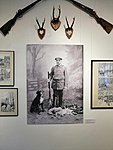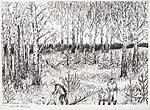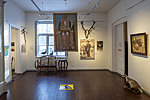16.02.-7.06.2020
“Forester's works, hunter's dreams and the transient world”
The
drawings by Vellu Tänav (1939–2019), who worked as a forester all
his life, are certainly a surprise to the viewers. The close to one
hundred drawings have been born out of inner compulsion, made for the
artist himself, clearly with the goal to remember bygone times and
record the forester's everyday works. The drawings have a nostalgic,
even a romantic dimension, because when they were created, the
occupation of forester no longer existed in Estonia. Vellu Tänav was
born in the Estonian island of Saaremaa and worked since 1966 as a
forester in Kobra forest disctrict, Pärnu County. Highly respected
by his colleagues, and building stoves as a side job, Vellu Tänav
only started drawing when he retired: his earliest pictures date from
the year 2000.
His
small detail-rich black-and-white drawings that depict forest and
farm work, animals and nature, and the several items connected with
the forester’s work enter into dialogue with Paul Kondas’
(1900–1985) paintings, which have never been exhibited before.
The paintings by Kondas from late 1950s also depict nature. Hunter’s Dream is a romanticised interpretation of the artist’s hunts in his youth. Because of his passion for hunting, the local newspaper wrote about schoolteacher Kondas in 1932: “Paul Kondas, the teacher of Suure-Jaani, is a man of various interests. In earlier years, he was a passionate billiard player and spent many nights at the billiard table. We do not know for sure whether he did not have much luck in this game or he finally understood that it would have a detrimental effect on his other activities, but soon he got bored with billiards. Then he started to set up symphony orchestras, but definitely failed to succeed with those. Now Kondas is a passionate hunter. Apparently, luck has lately also left him in this pastime. Last year, however, when there were more hare, Kondas often had such a good hunt that he could sell the hare on the marketplace. To increase this year’s scanty catch, Kondas has found quite an unconventional method. He has painted his black coat white with oil colours, hoping that when he wears this camouflage coat, more hare will come to him. People say the coat has not been of help, though. It remains to be seen whether in spring when grouse hunting starts, this ingenious man will paint his coat green again.” (Külaleht (Village Newspaper), 1932).
All the exhibited works belong to private collections. The exhibition was supported by the Estonian Cultural Endowment.
Mari
Vallikivi
%20(1)-1.jpg)



